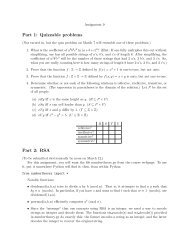Department of Mathematics - Math Department - Union College
Department of Mathematics - Math Department - Union College
Department of Mathematics - Math Department - Union College
You also want an ePaper? Increase the reach of your titles
YUMPU automatically turns print PDFs into web optimized ePapers that Google loves.
However, in my opinion, more important than what I studied is the thesis process itself. I would be<br />
remiss if I did not warn you about the tedious nature <strong>of</strong> the Thesis process. Unlike any other class<br />
you have taken, your Thesis Presentation is your Thesis Presentation. Therefore, you have to<br />
research everything, you have to derive and be able to clearly explain every step <strong>of</strong> your research<br />
and application. Also, it is really easy to fall behind and to feel lost. Therefore, procrastination<br />
cannot be an option and will surely negatively impact the quality <strong>of</strong> your presentation. Do not panic,<br />
this is typical. Simply continue to work hard and trust that your hard work will, in fact, pay <strong>of</strong>f<br />
greatly.<br />
In closing, as scary as all <strong>of</strong> this may sound, I have benefitted greatly from the thesis process. I<br />
definitely feel I manage my time more efficiently. More importantly, I gained a completely new and<br />
relevant set <strong>of</strong> knowledge about a topic I never knew existed. I hope that your experience with<br />
thesis will be as beneficial as mine was. Good luck, and remember that it is not about how much<br />
you have to stress or how lost you feel, it is about your ability to, simply, persevere.<br />
Record Number <strong>of</strong> Digits <strong>of</strong> Pi Calculated<br />
As reported by the BBC News<br />
(http://news.bbc.co.uk/2/hi/technology/8442255.stm), Fabrice<br />
Bellard claims to have computed the first 2.7 trillion digits <strong>of</strong> pi,<br />
establishing a world record. The record setting computation<br />
took 131 days on a desktop computer to complete and check.<br />
The previous record, some 123 billion digits less than what<br />
Bellard calculated, was set using a supercomputer in Japan<br />
that is 2000 times faster than the desktop used in this recent<br />
work and required only 29 hours <strong>of</strong> computing time.<br />
Problem <strong>of</strong> the Newsletter: February 5, 2010<br />
Congratulations to recent <strong>Union</strong> graduate, Andy Mackenzie ‘09 for correctly solving last week’s Problem <strong>of</strong><br />
the Newsletter, and an honorable mention to Tomas Kourim for progress toward a solution. Andy’s<br />
winning solution has been posted on the bulletin boards in Bailey Hall.<br />
Here is this week’s problem: Andy Mackenzie had so much fun with last week’s Putnam Exam problem<br />
that he suggested this week’s problem should be another Putnam Exam problem from a while back that he<br />
enjoyed playing with. Here it is.<br />
A Dyck n-path is a lattice path <strong>of</strong> n upsteps (1,1) and n downsteps (1, -1) that start at the origin O and never<br />
dips below the x-axis. A return is a maximal sequence <strong>of</strong> contiguous downsteps that terminates on the xaxis.<br />
For example, the Dyck 5-path illustrated has two returns, <strong>of</strong> length 3 and 1 respectively. Show that<br />
there is a one-to-one correspondence between Dyck n-paths with no return <strong>of</strong> even length and the Dyck (n-<br />
1)-paths.<br />
Pr<strong>of</strong>essor Friedman will accept solutions to this problem until 12:00 noon Thursday, February 11 th . Email<br />
your solution to him (friedmap@union.edu) or put it in his mailbox in the <strong>Math</strong> <strong>of</strong>fice in Bailey Hall.<br />
Page 2



